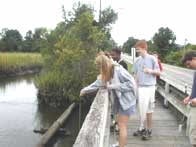You are here: Home › News › Feature Stories › South Carolina Phytoplankton Monitoring Network: A Working Example of Coastal Stewardship
South Carolina Phytoplankton Monitoring Network: A Working Example of Coastal Stewardship
 Phytoplankton, the tiny, floating plants that live in both freshwater and marine environments, can multiply into dense concentrations or blooms. A number of these species produce toxins that cause a variety of human diseases through inhaling toxins that might be in aerosol form along beaches or in consuming bivalve shellfish or some fish species which can accumulate the toxins. In South Carolina, citizens concerned about harmful algal blooms and algal species, such as Pfiesteria, have become part of the South Carolina Phytoplankton Monitoring Network (SCPMN). It serves as an early warning of blooms and potential toxins.
Phytoplankton, the tiny, floating plants that live in both freshwater and marine environments, can multiply into dense concentrations or blooms. A number of these species produce toxins that cause a variety of human diseases through inhaling toxins that might be in aerosol form along beaches or in consuming bivalve shellfish or some fish species which can accumulate the toxins. In South Carolina, citizens concerned about harmful algal blooms and algal species, such as Pfiesteria, have become part of the South Carolina Phytoplankton Monitoring Network (SCPMN). It serves as an early warning of blooms and potential toxins.
This is a volunteer network, forming a strong bond between researchers and the community. Developed and implemented by the National Centers for Coastal Ocean Science (NCCOS) through the Center for Coastal Environmental Health and Biomolecular Research (CCEHBR) in Charleston, this is the newest community effort of the Marine Biotoxins Program. Other community efforts include the Analytical Response Team, which responds to blooms associated marine morality and the Technology Transfer Team, which provides new technology and training of toxin detection methods.
The long-term goal of the program is to link algal blooms with specific parameters for ecological forecasting. Steve Morton of CCHEBR instructs teachers and students in phytoplankton sampling and identification. Along with plankton samples, the teams also measure temperature and salinity which can influence the blooms. Now completing its first year, the network has grown to include 23 high schools in Beaufort, Berkeley, Charleston, and Horry counties. Since January 2001, the SCPMN has also added citizen groups. These groups enhance the network by sampling in the summer, and NCCOS benefits by sharing coastal stewardship with a new constituent group.
The success of the monitoring network has been in increasing knowledge of harmful algae and identifying a number of potentially toxic species for the first time in South Carolina's waters (Dinophysis, Prorocentrum, and Pseudo-nitzschia). Information and communication between sampling groups and CCHEBR scientists takes place via an interactive web site developed by CCEHBR's Kimberly Nowocin.
For additional information about the SCPMN visit the interactive web site or contact Steve Morton (843-762-8501).
Related Links
Feature Story Archives
SC Task Group on Harmful Algae
Marine Biotoxin Program
Harmful Algal Blooms (HAB) Research and Control Act
Center for Sponsored Coastal Ocean Research Current HAB Projects
Center for Sponsored Coastal Ocean Research HAB Website Links



